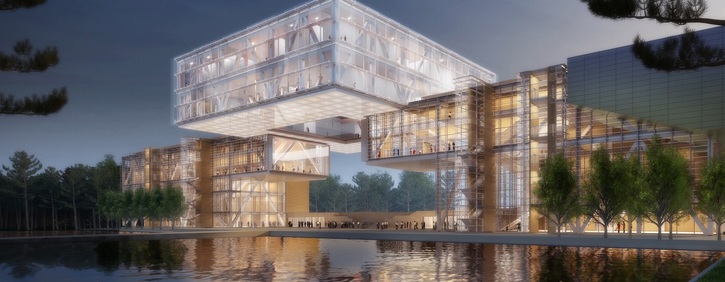ExxonMobil Leads the Way to Digital Transformation in
Corporate Real Estate

Digital transformation is a big buzzword today, and ‘transformation’ may have different meanings for different companies. Like many other large industries, oil and gas traditionally had been a late adopter of digital technology. A few years ago, we conducted a study tied to corporate digital strategy and identified a very large opportunity in the digital space for oil and gas. That led organizations within ExxonMobil to develop their own digital strategies, which are now synonymous with business strategy. We are looking at opportunities across the entire organization to really dive into developing capability teams to deliver on our digital ambition.
The Process
For us within Environmental & Property Solutions (E&PS), our specific goals are tied to strong economics. Like many companies, in the past we had worked as a siloed organization, which can lead to inefficiencies at the handoffs between sectors. We really hadn’t approached opportunities from a value stream or life cycle perspective.
Our new strategy led us to rethink the different business processes that support the execution of our competitive advantage. When you consider the large number of sites we are responsible for, it becomes clear that not all sites or environments are created equal. A site like Guyana or Mozambique is going to have very different priorities and opportunities than a flagship location like the Houston campus. So we initially defined a broad list of site personas and value stream processes that allowed us to look at things differently. Later we consolidated those down to four basic groups of roles and responsibilities; while everyone believes their role to be unique, we found a lot of synergies across functions due to the process work. It’s important to note the level of work and detail we expended to get to this stage. The value stream mapping allowed us to focus on end-to-end processes that crossed organizational silos.
The four personas include:
- The Customer: These are our business line clients; we are a support organization for the upstream, fuels and lubricants, and chemicals businesses.
- The Doer: These are our advisers and analysts, commercial developers, portfolio managers, site-project-specific managers.
- The Decision-Maker: Our executive managers and leadership team, C-managers and commercial managers; the people that are looking at data and making decisions.
- The Contractor: This covers all external support contractors, consultants, strategic suppliers and partners.
Successes
Our digital perspective for smart buildings ties into four specific tracks: operational efficiency, space management, financial stewardship and the resident experience. The smart building is the foundation and infrastructure to enable success from a data collection and aggregation standpoint, coupled with the work we are doing from an application perspective. Our vendor agnostic IoT smart building platform is truly best-in-class and something that we are really excited about. The platform makes the integration discussion a moot point because it doesn’t matter what BMS is installed, our project teams have flexibility. We are a global entity; all construction companies have different preferred vendors and we want to enable them to use the system effectively no matter where they are. This is accelerated operational efficiency through IoT, and we have kicked off our journey to reach our 18-month target to peak efficiency.
The work we’ve done with our unified data model is starting to take shape. E&PS are the stewards of location and site data for all of ExxonMobil and we are beginning to operationalize our site master. It’s really great to see that take shape.
Our new commercial ArcGIS tool that we are building in partnership with Esri is going to be a dramatic change with regard to anything that’s out there right now. It’s an experience/technician app with no beacons. It has multiple capabilities and also integrates with the work order management system.
Watch this ArcGIS Indoors demo:

We’re also implementing a digital ceiling on our Houston campus; we’ve selected a partner for PoE installation. Part of the work at that location is wireless retrofit so we can inform new builds as well as existing buildings. We have interest from one of our Gulf Coast sites to fully implement PoE as well, which will be huge from an energy consumption perspective.
Next Steps
All the large players in the tech space have product managers and product owners; it’s a newer concept within ExxonMobil. We’ve implemented Agile in regards to how we deploy technology but the next step to make it even more successful is to imbed product ownership within the business so that we really own the vision, the roadmap and the strategic direction of any technology we build and deploy.
Challenges: Talent and Change Management
The way that we’ve designed, built and deployed our tech pilots sets us up to scale and can work anywhere in the world. The challenges really are in adoption and talent. Like any large organization, there are always opportunities to improve when it comes to managing change.
 Humans tend to be risk-averse and honestly, that mindset works well in a lot of business lines. But driving change and transformation requires a value creator with a different perspective. Management in all industries must understand that it takes a persistent and creative mindset that is not easy to find. These people don’t give up; they find ways to make it work because they see the value. Much of the top tech talent tends to go to tech companies on the coasts; so that search for talent is a struggle.
Humans tend to be risk-averse and honestly, that mindset works well in a lot of business lines. But driving change and transformation requires a value creator with a different perspective. Management in all industries must understand that it takes a persistent and creative mindset that is not easy to find. These people don’t give up; they find ways to make it work because they see the value. Much of the top tech talent tends to go to tech companies on the coasts; so that search for talent is a struggle.
We also have to train the younger generation in the ways to drive digital. One of the avenues we’re using is designing and developing a new curriculum tied to product ownership. The training is broken into key segments such as design thinking, workshop facilitation, project management for digital, and process optimization. We’ll also do on-the-job training and shadowing.
Strategic Partnership Ecosystem
One of our corporate real estate innovation programs involved establishing a partner ecosystem and digital sandbox to test and vet new services and startups. Our enterprise architecture is a service-centric model and it takes various types of efficiencies to deploy digital initiatives and support tech. We’ve examined every type of service from cloud to various capabilities tied to exchange of data and the experience. There are some great solutions out there to discover.
Learn more about ExxonMobil’s and other leading companies' digital transformation journey at CoRE Tech on Nov. 13-15 in Silicon Valley. CoRE Tech 2019 is the leading conference on technology, automation and innovation for the Corporate Real Estate and Facilities industry. Register today!
This Week’s Sponsor
Aruba, a Hewlett Packard Enterprise company, is a leading provider of secure, intelligent networks that enable customers to thrive and deliver amazing digital experiences in the mobile, IoT and cloud era. We are changing the rules of networking to make it simple for IT and organizations to bridge the physical and digital worlds at the Edge. More information: arubanetworks.com.
Read Next
 3/27/2025
3/27/2025
The Convergence of Edge Computing, Cloud, and AI in Building Automation and Smart Buildings In the built environment, we have seen the convergence of Operational Technology (OT) and Information Technology (IT), later expanding to include Workplace Technologies (WP).
 3/27/2025
3/27/2025
DC Power: A Holistic Approach to Energy Savings in Commercial Buildings In today's energy-conscious world, businesses constantly seek ways to reduce their carbon footprint and operational costs.
 3/13/2025
3/13/2025
How to Achieve Eco-Friendly Facility Management Commercial real estate operators and facility managers are focusing on sustainable practices to minimize environmental impact, create healthier workplaces, improve productivity and lower operational costs.
 1/23/2025
1/23/2025
When It Comes To Managing Properties’ Parking, Technology Is Key It’s easy for developers and real estate owners to think of parking as a necessary evil. They know they have to provide it (often, because it’s mandated by code), they understand that prospective tenants and buyers expect to be provided parking, but they haven’t figured out how to maximize its value.








.gif)

